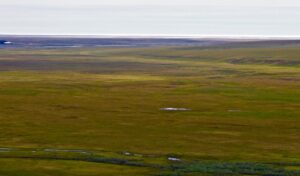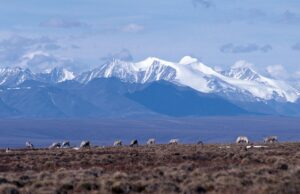
Trustees grew up protecting the Arctic Refuge
Trustees for Alaska grew up protecting the Arctic Refuge. In fact, we fought for the Arctic National Wildlife Refuge before it had its name.
We intervened on behalf of clients in 1979 when the State of Alaska sued President Carter for setting aside areas under consideration for protection in the then-proposed legislation now called the Alaska National Interest Lands Conservation Act. We argued that Congress, not a judge, should decide what lands get set aside. The court agreed and stayed the lawsuit.
Months later, Congress passed ANILCA and set the stage for a long, storied relationship between our homegrown Alaska law firm and the Arctic Refuge.
We sued James Watt and won
ANILCA changed the name of the Arctic National Range to the Arctic National Wildlife Refuge, and expanded the area to 18 million acres, the largest wildlife refuge in the country. The act also broadened protections for the land, water, wildlife, and habitat of the region.
Legal challenges began almost immediately. Just months after ANILCA’s passage, Interior Secretary James Watt transferred management of the Refuge from U.S. Fish and Wildlife Service to the U.S. Geological Survey. Watt intended the transfer to benefit industry.
We argued that the move ran counter to ANILCA. We won in court.

The Coastal Plain extends from the foothills of the Brooks Range to the Arctic Ocean. Photo courtesy of Vance Carruth.
Fighting for public input
The most contentious area of the Refuge centers on what legislators and industry people call the 1002 area—the coastal plain and biological heart of the Refuge. From the beginning, industry sought access to the coastal plain for oil and gas exploration and development. And the Reagan Administration wanted to give it to them.
We took Interior Secretary Hodel to court in 1985 when he refused to allow public involvement in the preparation of the Arctic Refuge Coastal Plain Resources Assessment (also known as the 1002 Report). This report evaluated whether to allow oil and gas development on the coastal plain.
We argued that the public should have had a chance to review a draft Legislative Environmental Impact Statement before a final report went to Congress.
We went to court and won again.
Early cases set the stage for long-term relationship
These early cases set the stage for decades of Trustees work in the Refuge. We have provided written testimony and testified before Congress. We have litigated in state court on issues related to potential impacts of state actions on the Refuge. We have strategized as legal experts with broad and diverse clients. And we have held agencies and leaders to account in court.
Our litigation work has ranged from participation as amicus curiae (“friend of the court”) in a dispute over the boundary of the Refuge in the 1997, to representing groups as interveners to defend Secretary of Interior Secretary Jewell’s decision not to allow seismic work on the coastal plain in 2015.
Now Congress has put the Arctic Refuge at risk by passing a tax bill in December that opens the coastal plain to drilling. We fought to protect the Arctic Refuge—the subsistence activities of the Arctic people, the wildness Americans value and want to protect, and the habitat of caribou, shorebirds, bears, fish, and other animals—long before the false promises of the tax bill helped push drilling through a shady budget process.
 As we face renewed threats from the Trump administration, Trustees will continue to defend America’s Arctic. We will fight to protect the Arctic Refuge now and into the future, just as we have always done.
As we face renewed threats from the Trump administration, Trustees will continue to defend America’s Arctic. We will fight to protect the Arctic Refuge now and into the future, just as we have always done.
Here’s a list of some of the legal actions Trustees has taken to protect the Arctic Refuge since passage of ANILCA:
- Trustees for Alaska v. Watt (1981) successfully challenged Interior’s attempt to change management of the Refuge from U.S. Fish & Wildlife Service to U.S. Geological Survey.
- Trustees for Alaska v. Hodel (1986) successfully challenged Interior’s failure to provide public review of a report to Congress on allowing oil and gas in the Coastal Plain.
- Trustees for Alaska v. State, Department of Natural Resources (Alaska 1990) and Trustees for Alaska v. State, Department of Natural Resources, (Alaska 1993), successfully challenged the State of Alaska’s failure to evaluate the impacts of oil and gas activities in state waters offshore of the Arctic Refuge on wildlife and habitat in the Arctic Refuge.
- U.S. v. Alaska (1997), participated as amicus in a dispute over the boundary of the Refuge. The US Supreme Court agreed that the tidelands along the northern coast were part of the Arctic Refuge because of the importance of those lands and coastal waters to species that rely on the Refuge.
- Gwich’in Steering Committee v. State (Alaska 2000), fought to require the State of Alaska to disclose its activities and public expenditures for lobbying to open the Coastal Plain to oil and gas activities.
- State v. Jewell (2015), represented groups as interveners and successfully defended the Secretary of the Interior’s decision not to allow harmful seismic exploration on the Coastal Plain.




